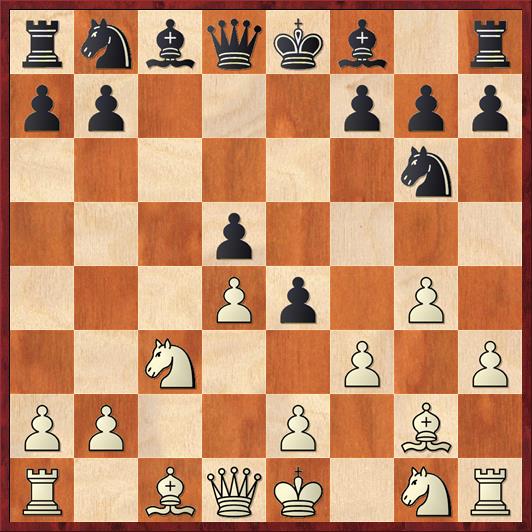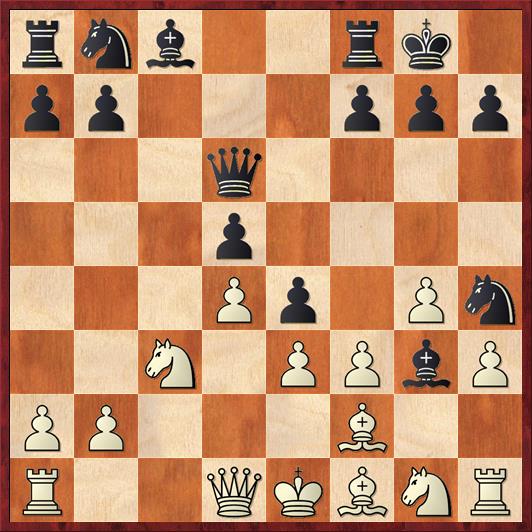So far this year, I haven’t written a single post about a game against the computer. I’ve been avoiding that on purpose, because I overdid it last year. But two of the things that give me the most satisfaction in life are beating the computer and beating the Grob. When the two come together, and it’s an entertaining game with three pawn sacrifices and a king hunt, how can I not write about it?
This was played yesterday against Shredder, with its rating set to 2220 (far below its top level, which is 2600, but strong enough to usually beat me).
Shredder – Dana
1. g4 d5 2. h3 e5 3. Bg2 Ne7
This is quite unusual, with only six games in Chessbase, compared to 515 games with the “normal” move 3. … c6. I’m not sure why there should be such a big difference; in many cases they can transpose.
4. d4 e4 5. c4 c6 6. Nc3 Ng6
Very provocative. It’s trying to put pressure on my center, and I remove a defender of the center. Of course, the reason is that I want to exploit the weaknesses on its kingside. To which Shredder replies: Weaknesses? What weaknesses?
7. cd cd 8. f3?! …
Position after 8. f3. Black to move.
FEN: rnbqkb1r/pp3ppp/6n1/3p4/3Pp1P1/2N2P1P/PP2P1B1/R1BQK1NR b KQkq – 0 8
If you asked me for one move that crystallizes the difference between computer chess and human chess, this would be it. No human would ever, ever consider such a move, which weakens an already porous kingside. But Shredder cares only about blowing up my center; and it correctly realizes that White has nothing to fear from 8. … Qh4+ 9. Kf1 ef, when either 10. Bxf3 or 10. Nxf3 Qd8 11. Qb3 win a pawn, with no real compensation for Black.
I’ve had so many games against the computer where it plays moves that, according to human intuition, should not be playable, and yet it wriggles out of trouble and even comes out ahead. It’s really nice, just for a change, to have a game where human intuition beats the brute-force calculating ability of the computer.
8. … Nh4! 9. Bf1 Bd6 10. Be3?! …
Another computer move. I think almost any human would try to close the diagonal with 10. f4. But Shredder doesn’t care. Rybka thinks that White should play 10. fe Bg3+ 11. Kd2 de with only a very slight (0.2-pawn) edge for Black, but I would have been happy to play this position.
10. … Bg3+ 11. Bf2 Qd6 12. e3 …
Practically the first “normal” move Shredder has played. The variation 12. fe Bxf2+ 13. Kxf2 de 14. e3 O-O would transpose to the game.
12. … O-O
I took quite a bit of time on this move. I think that 12. … f5 looks safer and probably I would play that move in a tournament game, but this was just a fun 10-minute game, and I thought, “What the hell. I just want to get my pieces out.” In addition, I wanted to see whether Shredder would be tempted to take the pawn sac.
Position after 12. … O-O. White to move.
FEN: rnb2rk1/pp3ppp/3q4/3p4/3Pp1Pn/2N1PPbP/PP3B2/R2QKBNR w KQ – 0 13
13. fe?! …
Hunch confirmed. This move is very consistent with Shredder’s previous moves. Safety is a foreign concept to Shredder; it just sees that it can win a nice center pawn.
Again, I think that a human player would avoid this move on principle and try to close lines and force Black to trade bishops with 13. f4. Even better (according to Rybka) is 13. Qe2 with the idea of playing 14. f4 next move; the point of 13. Qe2 is to allow White to reply to … Bxf2 with … Qxf2. Rybka evaluates the position as dead equal.
This goes to show that not all computer programs are the same. In this game I was definitely able to exploit Shredder’s hyper-aggressive tendencies.
13. … Bxf2+ 14. Kxf2 de 15. Nxe4 …
In for a penny, in for a pound.
15. … Qd5?!
My biggest misstep of this game. The queen turns out to be somewhat vulnerable here, because after … f5 it is on the same exposed diagonal as the king. The move 15. … Qe7! is just as threatening and doesn’t have the same liabilities.
16. Qc2 Be6 17. Kg3 …
Brave but also quite logical; White needs to get the king off the f-file.
17. … f5! 18. Kxh4? …
But now Shredder takes bravery one step too far. White has to try 18. Ng5, and Black’s best reply according to Rybka is 18. … Rc8 19. Qf2 (or Qh2), with an approximately equal position.
18. … fe 19. b3 Qd6!
Sacrificing a second pawn — but tightening the mating net around White’s king.
20. Qxe4 …
The critical moment of the game. How should Black proceed?
Position after 20. Qxe4. Black to move.
FEN: rn3rk1/pp4pp/3qb3/8/3PQ1PK/1P2P2P/P7/R4BNR b – – 0 20
I won’t lie to you. For a minute after White played 20. Qxe4 I thought that I had screwed up. The reason is that my intention here was to play 20. … Bd5, and at the last minute I realized that 21. Qxd5+! Qxd5 22. Bc4 squashes Black’s attack flatter than a pancake. Also, on most other “reasonable” Black moves, such as 20. … Nc6 or 20. … h6, 21. Qxe6+ basically ends the game.
So Black has to strike fast, and I started looking at 20. … g5+ almost out of desperation. And then it dawned on me — holy crap, it works! It’s always a bit of a surprise when the computer allows you to play a tactical shot like this, and I’m sure that it has to do partly with the fact that I’m playing Shredder at a rating of 2220, not its maximum rating.
This is actually a good argument for playing the computer at less than its maximum strength, because at maximum strength you get used to the fact that it never overlooks a tactical combination. At some point, you get out of the habit of even considering those possibilities, which is bad because your human opponents definitely will miss tactical shots and you have to practice spotting them and pouncing on them.
20. … g5+! 21. Kh5 …
It declines the sacrifice because 21. Kxg5 would allow 21. … Qd8+ 22. Kh5 Bf7+ 23. Kh6 Qh4 mate. This is quite ironic, because when White plays 1. g4 and 8. f3, you expect him to get mated by a queen check on h4 — but not quite in this fashion!
21. … Bf7+ 22. Kxg5 Qd8+ 23. Kf4 Bg6+ White resigns.
White has to give up the queen, and its king will still be exposed to a lethal attack. A rather amusing final position, because 4 of White’s 5 pieces are still on their original squares, and 3 of Black’s 5 pieces are also still on their original squares.
I hope you appreciated this trip into the bizarre world of computer chess!





